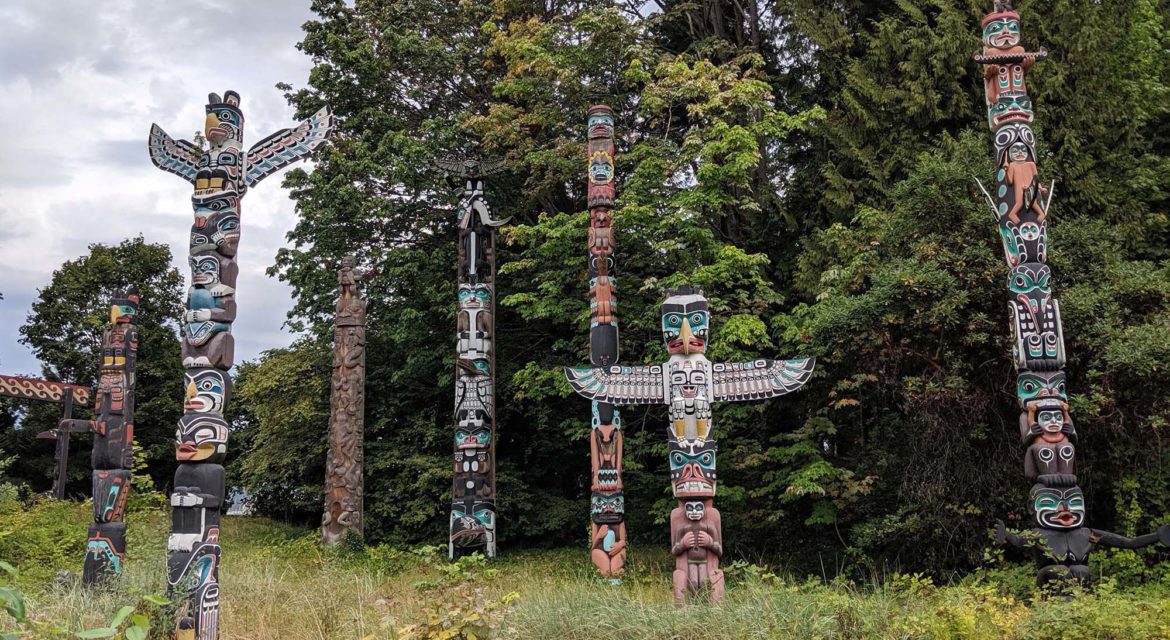 Stanley Park is home numerous activites and attractions, but the First Nations Totem Poles are the most popular of them all. Situated in a meadow at Brockton Point, the nine totem poles have been carved by a variety of Indigenous artists to become the most visited attraction in Vancouver, British Columbia, and possibly all of Canada. That popularity has allowed them to enable a tremendous economic impact on the park and for all of Vancouver.
Stanley Park is home numerous activites and attractions, but the First Nations Totem Poles are the most popular of them all. Situated in a meadow at Brockton Point, the nine totem poles have been carved by a variety of Indigenous artists to become the most visited attraction in Vancouver, British Columbia, and possibly all of Canada. That popularity has allowed them to enable a tremendous economic impact on the park and for all of Vancouver.
Distinct Meaning and History
 Totem poles are monuments created by First Nations of the Pacific Northwest to represent and commemorate ancestry, histories, people, or events. The current poles at Brockton Point have been carved by artists from various nations, including Squamish, Kwakwaka’wakw, Haida, Nisga’a, and Nuu-chah-nulth carvers.
Totem poles are monuments created by First Nations of the Pacific Northwest to represent and commemorate ancestry, histories, people, or events. The current poles at Brockton Point have been carved by artists from various nations, including Squamish, Kwakwaka’wakw, Haida, Nisga’a, and Nuu-chah-nulth carvers.
The collection of totem poles started at Lumberman’s Arch in the 1920s, when the Stanley Park Board bought four totems from Vancouver Island’s Alert Bay. Some of these original totem poles were carved as early as the 1880s. Additional totem poles came from Haida Gwaii (Queen Charlotte Islands) and the BC central coast Rivers Inlet, which were purchased to celebrate the 1936 Golden Jubilee. In the mid 1960s, the totem poles were moved to the more scenic and accessible Brockton Point.
Unfortunately, by the mid-1980s, many of the totem poles were damaged and rotting. Some of the damaged poles were put into museums with replicas being carved to take their place. The Skedans Mortuary Pole is a replica as the original was returned home to Haida Gwaii. Each of the totem poles has a distinct meaning and symbols associated with them.
 Raised in 2009, the Rose Cole Yelton Memorial Totem Pole was created to honor Rose Cole Yelton, her family and all those who lived in Stanley Park. The Oscar Maltipi Totem Pole highlights the origin stories that first nation people tell of animals and supernatural beings who helped found family lineages. The Chief Skedans Mortuary totem pole is the only one that contains a chief’s remains. The Chief Wakas Totem Pole represents the talking stick and characters in an Owikeno story belonging to Chief Wakas.
Raised in 2009, the Rose Cole Yelton Memorial Totem Pole was created to honor Rose Cole Yelton, her family and all those who lived in Stanley Park. The Oscar Maltipi Totem Pole highlights the origin stories that first nation people tell of animals and supernatural beings who helped found family lineages. The Chief Skedans Mortuary totem pole is the only one that contains a chief’s remains. The Chief Wakas Totem Pole represents the talking stick and characters in an Owikeno story belonging to Chief Wakas.
The Thunderbird House Post Totem Pole, Kakaso’Las Totem Pole, Beaver Crest Totem Pole, Ga’akstalas Totem Pole and Sky Chief Totem Pole also have distinct stories and histores, some of which can be experienced and remembered in a more personal manner at the Brockton Visitor Centre.

Activity, Imagery and Impact of the First Nations Totem Poles
 The Brockton Visitor Centre offers interpretive panels about the history and culture of the Coast Salish people. The gift shop also contains numerous items available for purchase, many of which incorporate the icons and imagery from the First Nations Totem Poles.
The Brockton Visitor Centre offers interpretive panels about the history and culture of the Coast Salish people. The gift shop also contains numerous items available for purchase, many of which incorporate the icons and imagery from the First Nations Totem Poles.
The Totem Poles are a popular attraction on the Horse-drawn Carriage Tour stops as well as the seasonal Stanley Park Shuttle. Maps that highlight activities and attractions in Stanley Park feature the totem poles in a major way, further signifying how important they have become.
That impact can be seen in terms of how the totem poles have been incorporated into items that are available for purchase across the city. The indirect economic impact that the totem poles represent to the approximately 8 million visitors that Stanley Park receives each year has a value that extends across the park and beyond.

Celebrating the Ancestry, Histories and People of the Pacific Northwest
 The First Nations Totem Poles in Stanley Park commemorate the ancestry, histories and people of the area in a powerful way. Doing so has created an incredibly popular attraction for visitors as well as a legacy that provides a sense of identity for the entire park and all of Vancouver.
The First Nations Totem Poles in Stanley Park commemorate the ancestry, histories and people of the area in a powerful way. Doing so has created an incredibly popular attraction for visitors as well as a legacy that provides a sense of identity for the entire park and all of Vancouver.


